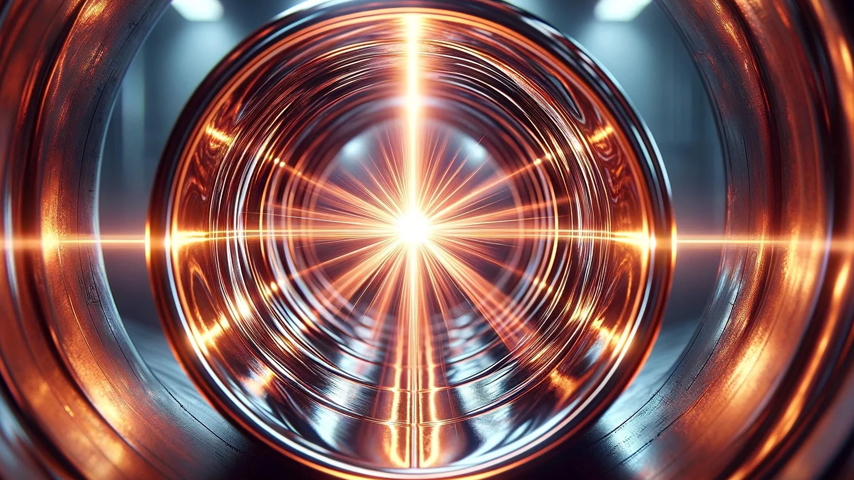Research Continues While Reducing Particle Collider Carbon Footprint
Research Continues While Reducing Particle Collider Carbon Footprint


More than a decade after confirming the existence of the Higgs boson, physicists aim to improve efficiencies for what’s next in the study of particle physics.
Higgs bosons play an incredibly important role in the understanding of the Standard Model of particle physics, said Emilio Nanni, assistant professor at Stanford University in California. He and his team at its linear accelerator center is advancing a proposal for a more sustainable way to study them.
“It determines your mass and the mass of every particle, which is really the driving foundation for what it means to exist,” Nanni said.
Some aspects of the Higgs boson are well understood but are yet to be tested. “Ultimately, what we'd like to do is use it as a tool for discovery,” he said.
It takes a lot of energy to create Higgs bosons and smash them together in the name of science. There are 30,000 accelerators, either linear or circular, already in use around the world. Most of them are found in commercial applications such as semiconductor manufacturing or healthcare.
Become a Member: How to Join ASME
Among the proposals for the next generation of high energy particle colliders capable of creating and supporting study of the Higgs boson is SLAC National Accelerator Laboratory’s proposal for the Cool Copper Collider, or C3, as it it nicknamed. C3 is a high energy e+ e- linear accelerator that uses a cryogenic copper distributed-coupling accelerating structure. Its design may lay the groundwork toward a more environmentally sustainable path for high-energy collider facilities.
To properly study Higgs bosons, physicists need to make a lot of them. A typical collider takes hundreds of megawatts to operate (in comparison, just one megawatt provides enough electricity to satisfy an instantaneous demand from 750 homes at once). The required intensity of the particle beam within the accelerator drives energy requirements, but there are a lot of other factors in play. In operational energy demands, hardware, equipment, and facilities constructed to house the accelerators also contribute to a collider’s embodied carbon.
“You can actually work on multiple different areas to improve sustainability instead of just trying to change one thing,” Nanni said. The SLAC team’s efforts to explore and develop sustainability strategies for the C3 are outlined in a paper recently published in PRX Energy.
The paper reviews financial and environmental impacts of both the embodied carbon and operational energy use of Higgs factories by proposing to create a metric that also includes the physics reach and quality of data in the equation.
“When you start thinking about it from that perspective, it's really valuable for the scientists too, because we want data,” Nanni said. “The more efficient we are at making that data, the more data we'll be able to produce for our experiment.”
And it’s not just energy efficiency. It’s lowering costs for better use of funding dollars that often include taxpayer money.
“Sustainability is a question that has to be answered about how the project is going and what kind of impact the project is going to have,” said Caterina Vernieri, an assistant professor at SLAC and one of the paper’s co-authors.
More for You: New System Could Reduce Data-Center Costs
C3 is the shortest of the current proposals for particle colliders, fitting within an 8 km footprint. That smaller size provides an automatic scaling down of its environmental impact through a reduced use of material. New colliders may be able to use more interchangeable parts and even employ different mechanisms for producing the particle beams they want to accelerate. However, a smaller facility also means there needs to be “a lot of energy to the beam in a short distance,” Nanni said.
“We tried to distill it down to what is the carbon footprint, both from construction and operations, for the science that you get out of it. That really leads you to some very different conclusions about kind of what type of machine would be the best and how should you operate it in order to get the best data out for your experiment,” he said.
The SLAC team identified key areas of technology development that may best take advantage of the physics capabilities of the C3.
Improving how power is converted from the grid into electromagnetic energy needed to accelerate the particles may come from the development of new devices. Advanced techniques for RF pulse compression may offer flexibility for achieving the power boost needed by storing electromagnetic energy in a cavity that acts like a battery before it’s discharged. Pulse compression led to “some interesting challenges” in C3’s cryogenic environment, “but there’s some good ideas about how we could make those and benefit in terms of the overall efficiency of the accelerator,” Nanni said. He said C3’s cryogenic environment may also help provide flexibility for another area of opportunity: beam format and repetition rates for pulse modes.
“Indications are that we can sustain these very, very intense electromagnetic fields for significantly longer because we're in the cryogenic environment,” Nanni said. These opportunities must be balanced with impacts to the accelerator, its ability to sustain a high accelerating gradient long enough and even if it results in “pileup,” which is too much data. Nanni is confident and excited about where the research will take the team. “We can be sustainable and have experiments that produce a lot of great physics,” he said.
Nancy Kristof is a science writer in Denver.
“It determines your mass and the mass of every particle, which is really the driving foundation for what it means to exist,” Nanni said.
Some aspects of the Higgs boson are well understood but are yet to be tested. “Ultimately, what we'd like to do is use it as a tool for discovery,” he said.
Lots of energy
It takes a lot of energy to create Higgs bosons and smash them together in the name of science. There are 30,000 accelerators, either linear or circular, already in use around the world. Most of them are found in commercial applications such as semiconductor manufacturing or healthcare.
Become a Member: How to Join ASME
Among the proposals for the next generation of high energy particle colliders capable of creating and supporting study of the Higgs boson is SLAC National Accelerator Laboratory’s proposal for the Cool Copper Collider, or C3, as it it nicknamed. C3 is a high energy e+ e- linear accelerator that uses a cryogenic copper distributed-coupling accelerating structure. Its design may lay the groundwork toward a more environmentally sustainable path for high-energy collider facilities.
To properly study Higgs bosons, physicists need to make a lot of them. A typical collider takes hundreds of megawatts to operate (in comparison, just one megawatt provides enough electricity to satisfy an instantaneous demand from 750 homes at once). The required intensity of the particle beam within the accelerator drives energy requirements, but there are a lot of other factors in play. In operational energy demands, hardware, equipment, and facilities constructed to house the accelerators also contribute to a collider’s embodied carbon.
Sustainability strategies
“You can actually work on multiple different areas to improve sustainability instead of just trying to change one thing,” Nanni said. The SLAC team’s efforts to explore and develop sustainability strategies for the C3 are outlined in a paper recently published in PRX Energy.
The paper reviews financial and environmental impacts of both the embodied carbon and operational energy use of Higgs factories by proposing to create a metric that also includes the physics reach and quality of data in the equation.
“When you start thinking about it from that perspective, it's really valuable for the scientists too, because we want data,” Nanni said. “The more efficient we are at making that data, the more data we'll be able to produce for our experiment.”
And it’s not just energy efficiency. It’s lowering costs for better use of funding dollars that often include taxpayer money.
“Sustainability is a question that has to be answered about how the project is going and what kind of impact the project is going to have,” said Caterina Vernieri, an assistant professor at SLAC and one of the paper’s co-authors.
More for You: New System Could Reduce Data-Center Costs
C3 is the shortest of the current proposals for particle colliders, fitting within an 8 km footprint. That smaller size provides an automatic scaling down of its environmental impact through a reduced use of material. New colliders may be able to use more interchangeable parts and even employ different mechanisms for producing the particle beams they want to accelerate. However, a smaller facility also means there needs to be “a lot of energy to the beam in a short distance,” Nanni said.
“We tried to distill it down to what is the carbon footprint, both from construction and operations, for the science that you get out of it. That really leads you to some very different conclusions about kind of what type of machine would be the best and how should you operate it in order to get the best data out for your experiment,” he said.
The SLAC team identified key areas of technology development that may best take advantage of the physics capabilities of the C3.
Improving how power is converted from the grid into electromagnetic energy needed to accelerate the particles may come from the development of new devices. Advanced techniques for RF pulse compression may offer flexibility for achieving the power boost needed by storing electromagnetic energy in a cavity that acts like a battery before it’s discharged. Pulse compression led to “some interesting challenges” in C3’s cryogenic environment, “but there’s some good ideas about how we could make those and benefit in terms of the overall efficiency of the accelerator,” Nanni said. He said C3’s cryogenic environment may also help provide flexibility for another area of opportunity: beam format and repetition rates for pulse modes.
“Indications are that we can sustain these very, very intense electromagnetic fields for significantly longer because we're in the cryogenic environment,” Nanni said. These opportunities must be balanced with impacts to the accelerator, its ability to sustain a high accelerating gradient long enough and even if it results in “pileup,” which is too much data. Nanni is confident and excited about where the research will take the team. “We can be sustainable and have experiments that produce a lot of great physics,” he said.
Nancy Kristof is a science writer in Denver.
